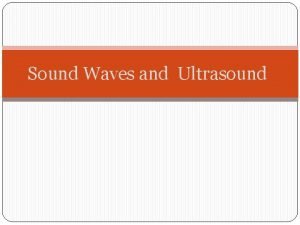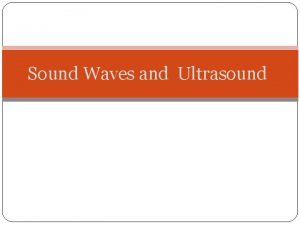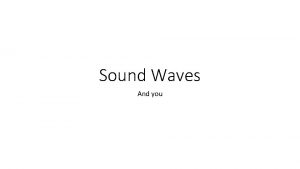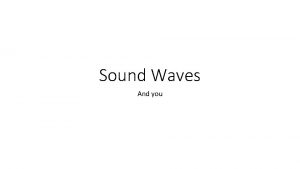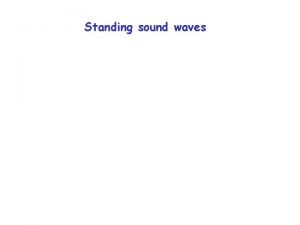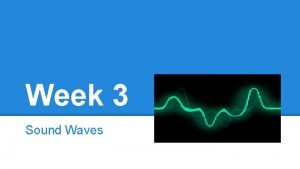REVIEW POWERPOINT SOUND WAVES SOUND WAVES A sound










- Slides: 10

REVIEW POWERPOINT SOUND WAVES

SOUND WAVES A sound wave is different than a light wave in that a sound wave is not capable of traveling through a vacuum. (in other words, SOUND cannot travel through outer space. ) • ****SOUND WAVES become PAINFUL at 120 decibels. Sound is a Mechanical Wave MECHANICAL WAVES MUST have a MEDIUM to travel / pass through.

WAVES NEED A MEDIUM! • MEDIUM – • the material through which a wave travels through – Remember: this medium will NOT move as a whole as the ENERGY is transmitted through it. • This includes ALL phases of MATTER. • TYPES OF MEDIUMS – -LAND -WATER -AIR

FREQUENCY - the number of complete waves, or complete cycles, per unit of time Because every complete wave has one crest and one trough, you can think of the frequency as the number of crests or troughs produced per unit time. The unit used to measure wave frequency is called the hertz (Hz). HERTZ is the SAME as ONE WAVE PER SECOND!

WAVELENGTH! WAVELENGTH – The distance between two consecutive (one after another) SIMILAR points on a wave; in other words, ***a measurement from one crest or trough to the next on a wave is called the wavelength. The wavelength can be measured from any point on a wave as long as it is measured to the same point on the next wave. This is ONE wavelength These are measured in METERS.

AMPLITUDE Amplitude • • The maximum distance the medium (the material through which a wave travels) moves away from its rest position. The higher the wave moves up-and-down as it vibrates, the larger the amplitude of the resulting waves. In simple terms, – AMPLITUDE IS THE HEIGHT OF THE WAVE! • Waves with high energy have a LARGE amplitude. • Waves with low energy have a SMALL amplitude.

WHAT IS A WAVE? Waves CAN BE transmitted through ALL PHASES OF MATTER (solid, liquid and gas) • A wave is - ANY DISTURBANCE that causes energy to travel from place to place. In other words, ALL WAVES TRANSFER ENERGY THROUGH A MEDIUM. • WAVES are created when a SOURCE OF ENERGY causes a MEDIUM to VIBRATE. • All waves, however, share certain basic characteristics: • ALL WAVES HAVE: 1. ) amplitude 2. ) wavelength 3. ) frequency. .

PARTS OF THE LONGITUDINAL WAVE COMPRESSIONS – part of the wave where the particles are CLOSE (crowded) together. RAREFRACTIONS – part of the wave where the particles are SPACED APART.

TRANSVERSE WAVES CREST - highest point of a wave X TROUGH - lowest point of a wave In this type of wave, the MOTION of the WAVE and the DIRECTION of the wave are at RIGHT ANGLES.

THE TWO TYPES OF WAVES! • LONGITUDINAL TRANSVERSE 1. ) COMPRESSIONS – (close together) 1. ) CREST - (highest point) Represented by the coils of the spring where there is a MAXIMUM DISPLACEMENT UPWARD of the particles. 2. ) RAREFRACTION – (far apart) Represented by the coils of the spring that are SPACED APART. 2. ) TROUGH – (lowest point) Represented by the coils of the spring where there is a MAXIMUM DISPLACEMENT DOWNWARD of the particles. Represented by the coils of the spring being CROWDED TOGETHER.
 Sound is a transverse wave true or false
Sound is a transverse wave true or false Mechanical and electromagnetic waves similarities
Mechanical and electromagnetic waves similarities Characteristics of a longitudinal wave
Characteristics of a longitudinal wave Sound is a longitudinal wave
Sound is a longitudinal wave Electromagnetic waves template
Electromagnetic waves template Transverse waves move perpendicular
Transverse waves move perpendicular Venn diagram mechanical and electromagnetic waves
Venn diagram mechanical and electromagnetic waves Short wave vs long wave radiation
Short wave vs long wave radiation Difference between matter waves and electromagnetic waves
Difference between matter waves and electromagnetic waves Examples of mechanical and electromagnetic waves
Examples of mechanical and electromagnetic waves Mechanical waves and electromagnetic waves similarities
Mechanical waves and electromagnetic waves similarities












